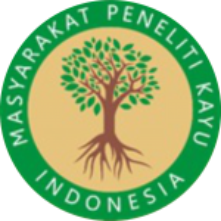Pengaruh Bleaching Terhadap Sifat Fisis Dan Perubahan Warna Kayu Pinus (Pinus merkusii Jungh et de Vriese) Terserang Blue Stain
The Effect of Bleaching on Physical Properties and Color Change of Blue Stain-Infected Pine Wood
DOI:
https://doi.org/10.22437/jurnalsilvatropika.v9i1.44803Keywords:
bleaching, color change, finishing, furniture, pineAbstract
ABSTRACT
Pine is one of wood species that widely used as raw material for furniture making. Pine is easy to obtain, easy to work with, and has distinctive colors and patterns. However, pine is susceptible to being attacked by contaminating fungi (blue stain) on its surface. Blue stain attack wood surface is a problem that must be solved due to its effect on wood appearance. The idea to restrain this problem is bleaching process. Bleaching process carried out in this study used 25% sodium hypochlorite which was dissolved in water in a ratio of 1:2 (w/w). The bleaching process carried out has a significant effect on moisture content (MC) of pine wood, but does not have a significant effect on its density. The MC value of pine wood after bleaching tends to increase compared to the untreated wood. The color change of pine wood after bleaching is indicated by the ΔE value (3.0 < ΔE < 6.0) which is classified as a moderate effect. The color of the control pine wood was originally slightly desaturated orange and after bleaching it became slightly desaturated orange
Keywords: bleaching, color change, finishing, furniture, pine.
ABSTRAK
Pinus merupakan salah satu jenis kayu yang banyak digunakan sebagai bahan baku pembuatan furnitur. Hal ini karena Pinus mudah mudah didapatkan, mudah dikerjakan, dan memiliki warna dan corak yang khas. Namun, Pinus rentan terserang jamur pengotor (blue stain) pada permukaannya. Serangan blue stain pada permukaan kayu merupakan permasalahan yang harus diatasi karena adanya seranagn blue stain dapat mempengaruhi penampilan kayu. Salah satu cara yang dapat dilakukan untuk mengatasi permasalahan tersebut adalah melakukan proses bleaching. Proses bleaching yang dilakukan pada penelitian ini menggunakan sodium hipoklorit 25% yang dilarutkan menggunakan air dengan perbandingan 1:2 (b/b). Proses bleaching yang dilakukan berpengaruh nyata terhadap kadar air (KA) kayu pinus, namun tidak berpengaruh nyata terhadap kerapatannya. Nilai KA kayu pinus setelah bleaching cenderung meningkat dibanding kontrolnya. Perubahan warna kayu Pinus setelah bleaching ditunjukkan dengan nilai ΔE (3,0 < ΔE < 6,0) yang tergolong pengaruhnya sedang. Warna pada kayu pinus control semula berwarna slightly desaturated orange dan setelah bleaching menjadi slightly desaturated orange.
Kata kunci: bleaching, finishing, furnitur, perubahan warna, pinus.
Downloads
References
Anggiriani S, Sutiawan J. 2023. Suatu Tinjauan Kecocokan Kayu Jati (Tectona grandis Linn F) Cepat Tumbuh untuk Bahan Baku Furnitur. Jurnal Kehutanan Papuasia, 9(1): 69-78.
Bomba J, Šedivka P, Böhm M, Devera M. 2014. Influence of moisture content on the bond strength and water resistance of bonded wood joints. BioResources, 9(3): 5208-5218.
Budakçi, M. 2006. Progress in Organic Coatings. 56: 46-52.
[BSI] British Standards Institution. 1957. BS 373: 1957 Methods of testing small clear speciments of timber. London: BSI.
Christie RM. 2015. Colour Chemistry 2nd edition. Cambridge: The Royal Society of Chemistry Science Park.
Cui W, Kamdem DP, Rypstra T. 2004. Diffuse reflectance infrared Fourier transform spectroscopy (DRIFT) and color changes of artificial weathered wood. Wood and Fiber Science. 291-301.
Damayanti FR, Sanjaya MAP, Kuncoro R, Radianto DO. 2024. Optimalisasi Boraks Sebagai Bahan Pelapis Tahan Api Pada Kayu Lapis. KOLONI. 3(2):144-153.
Fitrianto T, Anggiriani S, Muhamad S, Wijayanto A, Mulyosari D, Widiyanto W. 2025. Dampak Proses Bleaching terhadap Sifat Kimia dan Mekanis Kayu Karet yang Terinfeksi Blue Stain pada Produk Furnitur. Wahana Forestra: Jurnal Kehutanan, 20(1): 81-87.
Kasmudjo. 2012. Mebel dan Kerajinan, Teori Dasar dan Aplikasi. Yogyakarta: Cakrawala Media.
Kretschmann DE. 2008. The influence of juvenile wood content on shear parallel, compression, and tension perpendicular to grain strength and mode I fracture toughness of loblolly pine at various ring orientation. Forest Products Journal. 58(7/8): 89-96.
Krisdianto. 2013. Pengukuran warna kayu dengan sistem CIELab. Forpro, 2(1): 28–31.
Krisdianto K, Satiti ER, Supriadi A. 2018. Perubahan warna dan lapisan finishing lima jenis kayu akibat pencuacaan. Jurnal Penelitian Hasil Hutan.36(3): 205-218.
Kusumawardhani A, McCarthy G. 2014. Innovation in small and medium-sized wood-furniture firms in Central Java, Indonesia. In Proceedings of the International Conference on Managing the Asian Century: ICMAC 2013 (pp. 471-480). Singapore: Springer Singapore.
Li Z, Ge Y, Wan L. 2015. Fabrication of a green porous lignin-based sphere for the removal of lead ions from aqueous media. Journal of Hazardous Materials. 285:77-83.
Martawijaya A, Kartasujana I, Mandang YI, Prawira SA, Kadir K. 2005. Atlas Kayu Indonesia Jilid II. Jakarta: Departemen Kehutanan.
Mattjik AA, Sumertajaya IM. 2013. Perancangan Percobaan dengan Aplikasi SAS dan Minitab Jilid I. Bogor: IPB Press.
Mester T, Varela E, Tien M. 2004. Wood degradation by brown-rot and white-rot fungi. In Genetics and biotechnology (pp. 355-368). Berlin, Heidelberg: Springer Berlin Heidelberg.
Nie S, Zhang K, Lin X, Zhang C, Yan D, Liang H, Wang S. 2018. Enzymatic pretreatment for the improvement of dispersion and film properties of cellulose nanofibrils. Carbohydrate Polymers.181: 1136-1142.
Nurhanifah N, Anggiriani, S, Muhamad S, Wijayanto A, Mulyosari D, Fitrianto TR, Widiyanto W. 2024. Proses bleaching: implikasinya pada perubahan warna dan sifat fisis kayu karet (Hevea Brasiliensis) terkena blue stain. Tengkawang: Jurnal Ilmu Kehutanan.14(2): 108-115.
Ogata K, Fujii T, Abe H, Baas P. 2008. Identification of The Timbers of Southeast Asia and The Western Pacific. Japan: Kaiseisha Press.
Ozgenc O, Hiziroglu, Yildiz U. C. 2012. Weathering properties of wood species treated with different coating applications. BioResources, 7(4): 4875–4888. doi: 10.15376/biores.7.4.4875- 4888.
Priadi T, Hiziroglu S. 2013. Characterization of heat treated wood species. Materials & Design.49: 575-582.
Puspita AAPA, Sachari A, Sriwarno AB. 2016. Dinamika Budaya Material pada Desain Furnitur Kayu di Indonesia. Panggung. 26 (3):247–260.
Sala CM, Robles E, Gumowska A, Wronka A, Kowaluk G. 2020. Influence of moisture content on the mechanical properties of selected wood-based composites. BioResources.15(3): 5503.
Sokanandi A, Pari G, Setiawan D, Saepuloh S. 2014. Komponen kimia sepuluh jenis kayu kurang dikenal: kemungkinan penggunaan sebagai bahan baku pembuatan bioetanol. Jurnal Penelitian Hasil Hutan. 32(3): 209-220.
Suheryanto D, Haryanto T. 2009. Pemanfaatan kayu karet untuk furniture. In Dalam Prosiding Seminar Nasional Penelitian, Pendidikan dan Penerapan MIPA (pp. 1-8).
Uysal B, Atar M, Özçifçi A. 1999. The Effects of Wood Bleaching Chemicals on theBending Strength of Wood. Turkish Journal Of Agriculture And Forestry. 23(6):615-620.
Van Hai L, Pham DH, Kim J. 2022. Effect of Bleaching and Hot-Pressing Conditions on Mechanical Properties of Compressed Wood. Polymers. 14(14): 2901.
Wijayanto A, Nurhanifah N, Anggiriani S, Muhamad S. 2023. Pengaruh perlakuan bleaching terhadap perubahan warna dan sifat finishing kayu pinus (Pinus sp.) terserang blue stain. Jurnal Riset Industri Hasil Hutan. 15(1): 13-20.
Wu Y, Wu J, Yang F, Tang C, Huang Q. 2019. Effect of H2O2 bleaching treatment on the properties of finished transparent wood. Polymers. 11(5): 776.
Downloads
Published
How to Cite
Issue
Section
License
Copyright (c) 2025 Siska Anggiriani, Arip Wijayanto, Nurhanifah Nurhanifah, Soleh Muhamad, Desy Mulyosari, Wahyu Widiyanto, Taufik Ramadhan Fitrianto

This work is licensed under a Creative Commons Attribution 4.0 International License.
















